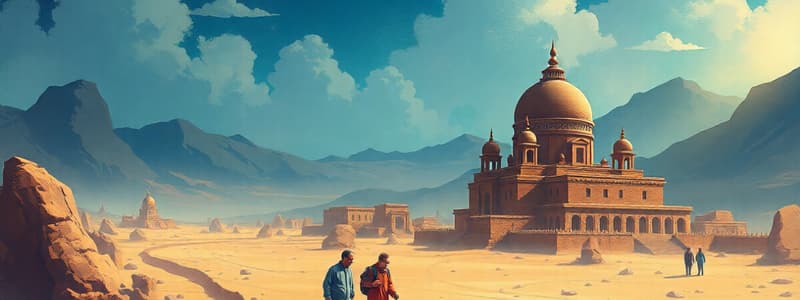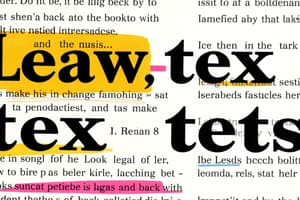Podcast
Questions and Answers
Which characteristic is LEAST likely to be found in journalistic text?
Which characteristic is LEAST likely to be found in journalistic text?
- Clear and concise language.
- Focus on current events.
- Use of complex, technical jargon. (correct)
- Objective reporting of facts.
In the inverted pyramid structure of journalistic writing, how are details arranged?
In the inverted pyramid structure of journalistic writing, how are details arranged?
- Chronologically, as they occurred.
- From least crucial to most vital details.
- From most vital details to least crucial details. (correct)
- Based on the emotional impact on the reader.
Which type of journalistic text is MOST likely to include personal opinions and interpretations?
Which type of journalistic text is MOST likely to include personal opinions and interpretations?
- Feature Article
- Sports Writing
- News Report
- Editorial/Opinion Piece (correct)
What language was predominantly used in the earliest forms of Indian literature?
What language was predominantly used in the earliest forms of Indian literature?
Which of the following is a central theme commonly found in Jewish literature?
Which of the following is a central theme commonly found in Jewish literature?
What type of writing is MOST exemplified by the Psalms?
What type of writing is MOST exemplified by the Psalms?
In the story of Ruth, what motivated Naomi to return to Judah?
In the story of Ruth, what motivated Naomi to return to Judah?
What action did Ruth take that demonstrated her loyalty to Naomi?
What action did Ruth take that demonstrated her loyalty to Naomi?
What role did Boaz play in Ruth's life?
What role did Boaz play in Ruth's life?
During the Pre-Islamic era, what was a common focus of Arabian oral poetry?
During the Pre-Islamic era, what was a common focus of Arabian oral poetry?
Which figure of speech is used in the phrase: 'The desert whispers ancient secrets'?
Which figure of speech is used in the phrase: 'The desert whispers ancient secrets'?
Which type of Arabian literature focuses on ethical teachings and moral guidance?
Which type of Arabian literature focuses on ethical teachings and moral guidance?
In the context of Arabian Nights, what are 'Jinn' BEST described as?
In the context of Arabian Nights, what are 'Jinn' BEST described as?
What is the Latin origin of the word 'literature'?
What is the Latin origin of the word 'literature'?
Which sequence BEST describes the typical plot structure in literature?
Which sequence BEST describes the typical plot structure in literature?
What is the role of the antagonist in a story?
What is the role of the antagonist in a story?
What does the term 'theme' refer to in literature?
What does the term 'theme' refer to in literature?
If a story is told from a 'Third-Person Limited' point of view, what does this MOSTLY indicate?
If a story is told from a 'Third-Person Limited' point of view, what does this MOSTLY indicate?
Which of the following BEST describes 'Oral Literature'?
Which of the following BEST describes 'Oral Literature'?
Which of these options involves the use of rhythmic and artistic expression?
Which of these options involves the use of rhythmic and artistic expression?
Flashcards
Journalistic Text
Journalistic Text
Reports current events and informs the public.
Factual and Objective
Factual and Objective
Accurate, unbiased reporting supported by evidence.
Lead (Inverted Pyramid)
Lead (Inverted Pyramid)
Most vital details (Who, What, When, Where, Why, How) at the beginning.
Purpose of Journalism: To Inform
Purpose of Journalism: To Inform
Signup and view all the flashcards
News Reports
News Reports
Signup and view all the flashcards
Feature Articles
Feature Articles
Signup and view all the flashcards
Editorials/Opinion
Editorials/Opinion
Signup and view all the flashcards
Vedas
Vedas
Signup and view all the flashcards
Rig Veda
Rig Veda
Signup and view all the flashcards
Mahabharata
Mahabharata
Signup and view all the flashcards
Ramayana
Ramayana
Signup and view all the flashcards
Kalidasa
Kalidasa
Signup and view all the flashcards
The Holy Bible
The Holy Bible
Signup and view all the flashcards
Old Testament
Old Testament
Signup and view all the flashcards
Narrative (Jewish Literature)
Narrative (Jewish Literature)
Signup and view all the flashcards
The Story of Ruth
The Story of Ruth
Signup and view all the flashcards
Kinsman-Redeemer
Kinsman-Redeemer
Signup and view all the flashcards
Themes of Arabian Literature
Themes of Arabian Literature
Signup and view all the flashcards
Genii (Jinn)
Genii (Jinn)
Signup and view all the flashcards
Plot
Plot
Signup and view all the flashcards
Study Notes
- Journalistic text reports current events and informs the public.
Characteristics of Journalistic Text:
- Factual and objective: It is accurate, unbiased, and supported by evidence.
- Clear and concise: It is written in simple language with a straightforward structure.
- Timely and relevant: It focuses on current events and issues.
Content Structure:
- Title/Headline: Captures attention.
- Author/Byline: Identifies the writer.
- Inverted Pyramid Structure:
- Lead: Most vital details (Who, What, When, Where, Why, How).
- Body: Additional details, context, and quotes.
- Tail: Background information (least crucial details).
Purposes of Journalistic Text:
- To inform: Provides straightforward information.
- To persuade: Changes perspectives.
- To entertain: Engages the audience.
Types of Journalistic Texts:
- News Reports: Factual, concise, and direct.
- Feature Articles: In-depth analysis of events.
- Editorials/Opinion: Expresses ideas and comments.
- Sports Writing: Game results, analysis, and key players.
Indian Literature: History and Language
- Earliest Literature (300 B.C.): Written in Sanskrit.
- Vedic Texts: "Vedas" (knowledge), sacred texts of Aryans.
Major Works:
- Rig Veda: Hymns dedicated to Aryan Gods.
- Mahabharata: Longest epic, cousin rivalry between the Pandavas and Kauravas over the throne of Hastinapur, Kurukshetra War, the Pandavas won with the help of Lord Krishna.
- Ramayana: Story of Prince Rama’s journey to save Sita, who was kidnapped by Ravana and aided by his brother Lakshmana and Hanuman (monkey warrior).
- Upanishads: Philosophical dialogues between teachers and students.
- Puranas: History of the Aryan race and Gods.
Evolution of Indian Literature:
- 400 B.C.: Sanskrit evolved into poetry and drama.
- Shastra: Manual of instruction and a book of knowledge and religious ideas.
- Shakuntala: Story of love and separation.
- Kalidasa: Renowned poet, wrote Shakuntala.
- Mahatma Gandhi: Leader of India, introduced Satyagraha (peaceful resistance).
- Rabindranath Tagore: Nobel Prize-winning poet and dramatist.
Jewish Literature: Origins
- Israel: Center of Jewish literature.
- The Holy Bible: Greatest literary work, divided into the Old Testament (history and teachings before Jesus Christ) and the New Testament (life and teachings of Jesus Christ).
- Only accepted the Old Testament as "bible".
Characteristics of Jewish Literature:
- Love of God: Central theme.
- Hymns of Praise: Devotion through songs.
- Emotional and passionate: Reflects true-life experiences.
- Love for Country and Culture: Preserves Jewish traditions.
Types of Jewish Literature:
- Lyric: Poetic songs about culture and devotion.
- Narrative: Biblical stories with Jewish themes.
- Drama: Stories about faith, struggles, and justice.
Psalms (Religious Poetry):
- Psalms of Praise: Gratitude and worship.
- Psalms of Trust: Comfort and encouragement.
- Psalms of Contrition: Sorrow and repentance.
The Story of Ruth
- Biblical story from the Book of Ruth (Old Testament).
- Themes: Faith, loyalty, and redemption.
Key Events:
- Elimelech and Naomi had two sons, Mahlon and Chilion, and moved from Judah to Moab due to famine.
- Mahlon and Chilion married Moabite women, Orpah and Ruth.
- Elimelech, Mahlon, and Chilion died, leaving Naomi with her daughters-in-law.
- Naomi decided to return to Judah after the famine ended.
- She encouraged Orpah and Ruth to stay in Moab and remarry; Orpah stayed, but Ruth refused.
- Ruth's famous words: "Where you go, I will go; where you lodge, I will lodge; your people shall be my people, and your God my God." (Ruth 1:16)
- They arrived in Judah and Ruth worked in the fields of Boaz, Naomi’s relative, to gather leftover grains.
- Boaz admired Ruth’s hard work and loyalty, and Naomi advised Ruth to ask Boaz to be her Kinsman-Redeemer (a relative who marries the widow to continue the family line).
- Boaz agreed but had to settle legal matters first, as there was a closer relative who had the right to marry Ruth.
- The closer relative refused, allowing Boaz to marry Ruth.
- Ruth and Boaz married and had a son, Obed.
- Obed became the father of Jesse, the father of King David.
- Ruth became part of the genealogy leading to Jesus Christ, fulfilling Old Testament prophecies.
Arabian Literature: Historical Background
- Pre-Islamic Era: Oral poetry focused on tribal pride and love.
- Arabian Empire: Flourished in literature, arts, and sciences due to the pursuit of knowledge.
- Caliphs: Arabian rulers supported literature and served as patrons of literature.
Characteristics of Arabian Literature:
- Themes: Love, morals, and religion.
- Figurative Language:
- Simile (Tashbih): “Her eyes are like pools of dark honey.”
- Metaphor (Isti’ara): “He is a lion in battle.”
- Personification (Tashkhis): “The desert whispers ancient secrets.”
Golden Age of Arabian Literature:
- Poetic Forms:
- Qasida: Odes.
- Ritha: Elegies.
- Ghazal: Love poetry.
- Adab: Ethical writing.
- Mythical Beings:
- Genii (Jinn): Spirits, both good and evil.
- Peris: Beautiful spirits of goodness.
- Ghouls: Flesh-eating creatures in graveyards.
- Religious Beliefs:
- Mohammedian Paradise: Ultimate reward.
- Houris: Beautiful maidens in paradise.
- Mohammedian Hell: Full of terror and suffering.
Arabian Nights (Folktales):
- Aladdin: Magical adventures.
- Sinbad: Voyages and adventures.
Elements of Literature
- Originates from the Latin term “Litera,” meaning letters or writing.
Types of Literature:
- Oral Literature: Passed down through word of mouth.
- Written Literature: Expressed through written forms.
Forms of Literature:
- Prose: Straightforward structure (novels, essays).
- Poetry: Rhythmic, artistic expression.
Elements of Literature:
- Plot: Sequence of events in a story.
- Exposition: Introduces setting and characters (Beginning).
- Rising Action: Develops conflicts, leading to the peak.
- Climax: Turning point, highest tension.
- Falling Action: Consequences of climax.
- Resolution (Denouement): Story conclusion.
- Characters:
- Protagonist: Main character (hero).
- Antagonist: Opposes the protagonist.
- Setting: Time and place.
- Theme: Underlying message or implied idea.
- Language: Word choice and literary devices.
- Point of View (POV):
- First-Person: “I,” “me,” “my.”
- Second-Person: “You.”
- Third-Person: “He,” “she,” “they.”
- Limited: Focuses on one character’s thoughts.
- Omniscient: Knows multiple characters’ thoughts.
Studying That Suits You
Use AI to generate personalized quizzes and flashcards to suit your learning preferences.




